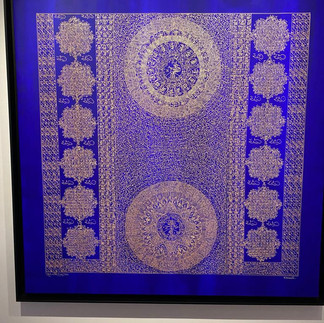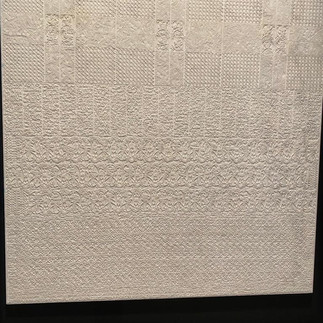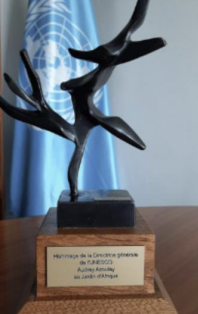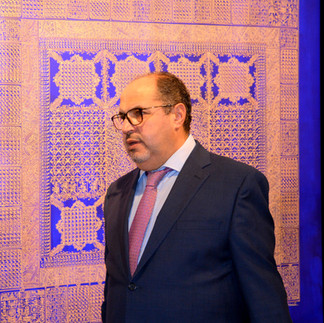Rachid Koraïchi: Le Chant de l’Ardent Désir | The Song of Burning Desire
- Society Diplomatic Review
- Feb 7, 2022
- 4 min read
Updated: Feb 8, 2022

Photo: Courtesy of Nabila Amghar, Editor and Events Coordinator of Society & Diplomatic Review
Aicon New York is proud to present Le Chant de l’Ardent Désir, the third major U.S. solo exhibition of Algerian born artist Rachid Koraïchi. The exhibition runs concurrently with the recent opening of Jardin d'Afrique, Jardin du Paradis. This UNESCO recognized world heritage site in Zarzis, a coastal commune in southeastern Tunisia, is a paradise-like garden conceived by Koraïchi as a final resting place for migrants who died, often anonymously, at sea. Why has he taken on this task? In part because of something his grandfather told him on his deathbed: "He who dies very rich has missed his life because he did not know how to share." Koraïchi is not only a supremely talented artist but also an exceedingly generous human being
Koraïchi's exhibition Le Chant de l'Ardent Désir is comprised of four bodies of work rooted in his ground-breaking interpretations of calligraphic modernism. In continuation with his earlier series, Koraïchi plays with the number seven throughout the exhibition both theoretically and literally. The artworks appear in multiples of seven; there are fourteen canvases, fourteen steel sculptures, and a group of six alabaster tablets lining the path to a monumental tapestry. It is a divine number and omnipresent. The fourteen canvases are luminous golden-white acrylic paint on a background of vibrant indigo, a color that references Koraïchi's silk banners which have been a constant presence in his artistic practice. Although softer in material and hanging on walls, these paintings are reminiscent of the ceramic tiles that line the floors of mosques as well as the entryway of the Tunisian cemetery. As such, they transform the gallery into an ad-hoc shrine, an inclusive place to worship the beauty and universality of art. Also on display is a room of alabaster tablets on a scale that has not been seen before. Four times as large as his earlier works in the same medium, these new creations with their tombstone-like appearance work in tandem with the woven tapestry depicting the Jardin d'Afrique. When lit, the surface of the alabaster takes on a fleshy quality, almost as if they are the skin from the skeletal corten steel sculptures standing as sentinels down the center of the gallery.
Photos: Courtesy of Nabila Amghar, Editor and Events Coordinator of Society & Diplomatic Review
Koraïchi was born in Ain Beida, Algeria in 1947 and now lives and works in Paris with major projects in Algeria, Egypt, Spain, Tunisia, the USA, and Dagestan. Koraïchi’s work is influenced by his heritage as a Quraishite, a transcriber of Quranic text, in the Aurès region of Algeria. Language, whether written or spoken, transmits history, faith, culture, and life. For African artists in particular, it is a powerful combatant against pernicious myths about Africa’s supposed lack of history or letters, as well as a medium for visual experimentation. The artist’s exploration of script quickly evolved to meld characters from Arabic with his own personal system of codes, numbers, and marks. He has referred to his visual lexicon as an ‘alphabet of memory,’ using it to articulate not only his aesthetic vision, but also his views on co-existence, tolerance, and perseverance.

Photo Credit: Society & Diplomatic Review
His practice extends across an impressive range of media, including ceramics, textiles, bronze sculptures, and canvases. He engages local artists and craftsmen trained in ancient traditions to craft pieces for site-specific installations. Koraïchi won the prestigious Jameel Prize in 2011. The artist presented installations at the Emirates Palace in Abu Dhabi in 2011 and Marrakech Biennale in 2016. He was included in both the 47th and 49th Venice Biennales. Koraïchi was shown in the inaugural exhibition at the Guggenheim Abu Dhabi in 2015 as well as The Future of Tradition, Haus der Kunst, Munich, 2010; Word into Art, The British Museum, 2006; and Without Boundary: Seventeen Ways of Looking, MoMA, 2006.
In 2021, Koraïchi was invited by the President of the Republic of Tunisia, the UNESCO Director-General Audrey Azoulay who visited Tunisia between June 7-9, as part of the partnership between Tunisia and UNESCO in the fields of education, culture and more specifically on heritage. On this occasion, the Director-General wished to pay tribute to migrants. During a ceremony in Zarzis, she offered a "Tree of Peace" to the Algerian artist Rachid Koraïchi for his Garden of Africa, a place created to give a final resting place to migrants who have tragically lost their lives while trying to cross the Mediterranean.
The Tree of Peace is a sculpture by Hedva Ser, UNESCO Goodwill Ambassador for Cultural Diplomacy. This artwork brings together, in a web of knotted branches, soaring doves and the values of peace promoted by the United Nations. Since 2012, Hedva Ser's Tree of Peace is the official UNESCO trophy, awarded by the Director-General to each peacemaker in the world.
The exhibition will run through February 3rd to March 12, 2022 located at 35 Great Jones Street. The opening VIP reception was on February 3rd where the Consul General of Algeria, Hon. Chennouf Brahim, the guest of honor came to show his support for his long time friend, Koraïchi. Dr. Prajit Dutta, the owner of Aicon Gallery greeted and welcomed the VIP guests.
For more information on the exhibition: erica@aicongallery.com



























































































Comments